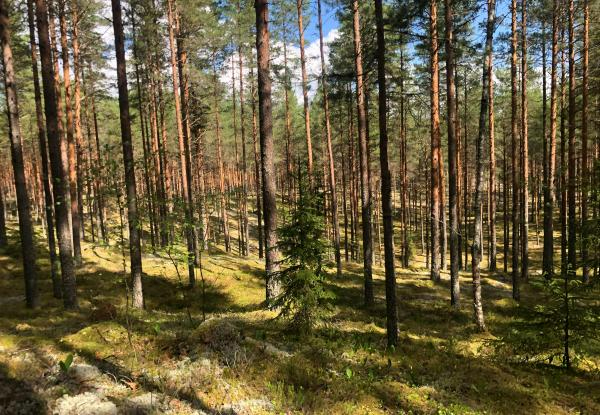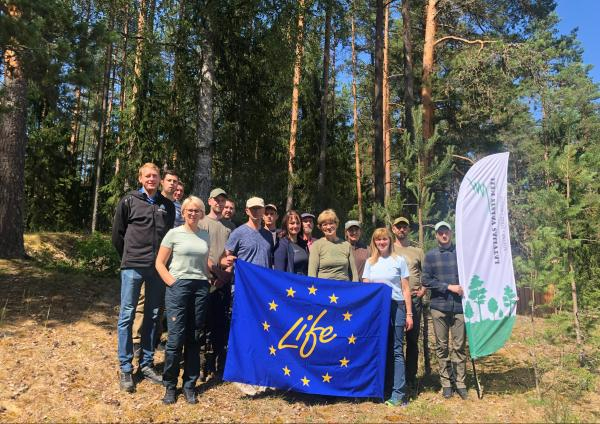LVM to Test Methods for the Management of Lichen-rich Pine Forest Habitats in Inland Dunes
This autumn, JSC “Latvia's State Forests” (LVM) will start carrying out various biotechnical measures in the protected landscape area “Ziemeļgauja” for the diversification and improvement of the forest habitat – lichen-rich pine forests in the inland dunes. At the same time, methods for the future management of this habitat will be identified, which will allow promoting the value of the habitat in the future. An informative seminar was held on 28 July in the areas of the works to inform those involved about the scope and course of the planned works.
Lichen-rich pine forest habitats are mostly found at sites where there are the largest inland dune massifs. The protected landscape area “Ziemeļgauja” is one of the rare places in Latvia where inland dunes can be found – a rare geomorphological value in Europe, which was formed as a result of various processes taking place inland and over time became forested. Inland dunes are an important habitat for several rare and highly protected species of plants, lichens and animals that are only to be found in open, dry, and nutrient-poor places. As the necessary natural disturbances decrease, the habitat will be enriched with nutrients and subsequently such living conditions that are suitable for inland dune species will disappear. In the territory of “Ziemeļgauja” protected landscape area, in addition to the lack of natural disturbances, the forestry works carried out during the Soviet period also adversely affected the state of the biotope, as it did not provide the existence of various necessary natural structures such as tree stands of various ages, individual old trees, openings, cracks, dried roots, sand substrate area, etc.
To improve the condition of the homogeneous biotope and find solutions for its future management, LVM has established a pilot territory of 37 hectares in the Eastern Vidzeme region. In the pilot plot, forestry works will be carried out to ensure the presence of various natural values in the forest: biologically valuable trees with wide, branched crowns and thicker in diameter, as well as dead wood. Openings and mineral soil outcrops will also be created to simulate the action of fire.
“Natural disturbance to such forests includes fire, and after a fire, various natural structures remain there, such as burnt trees, stumps, various fallen areas, openings, exposed mineral soil, and also surviving trees or groups of trees, which further integrate into the development of a new forest and ensure a high biological diversity of the forest, thus creating tree stands of different ages,” says LVM Environmental Planning Specialist Kaspars Liepiņš.
The purpose of the planned works is not only to improve the condition of the habitat in a specific area, but also to evaluate and find the most suitable solutions for the management of such a habitat to be used in the future and for the long-term preservation of these natural values in other places both in Latvia and Europe.
“The promotion of natural forest structures in this area is planned by carrying out sanitary felling with additional conditions, applying logging technologies that are available in the practice of forest management today. It is expected that sanitary felling of trees will be carried out with a stockpile harvester, and the delivery of timber and cutting residues – with a forwarder,” says Gunta Dudele, LVM East Vidzeme Forest Management Planning Manager.
For work equipment to be able to move around the territory, carrying out the planned works and purposefully creating disturbances in the ground cover necessary for the habitat, thoughtful planning of technological corridors has been carried out, and where possible, older corridors will also be used. In the work area, the trees to be left are already marked with red and green colours – the most biologically valuable trees and trees that will be used as additional dead wood necessary for this habitat.
The works are planned to start in the autumn of 2023 and will continue until the end of 2025. This area will also be one of the places where remote sensing forest monitoring methodology will be developed and tested; this task will be performed by LVM specialists.
Representatives of LVM, the State Forest Service and SIA “Rīgas Meži” took part in the information seminar for the parties involved.
Within the framework of the “LIFE-IP LatViaNature” project, LVM plans habitat restoration works in three specially protected Natura 2000 territories: in the nature park “Engures ezers”, in the nature reserve “Grebļu kalns”, in the protected landscape area “Ziemeļgauja” and in the inland dune of Zvirgzde with a total area of 100 hectares. All these areas are notable for the presence of European rare and protected geologically determined forest habitats that are dependent on natural disturbances: wooded coastal dunes, lichen-rich pine forests, coniferous forests on ossified landforms, as well as old and natural boreal forests in dry growing conditions, part of the areas are important habitats for hunters.





